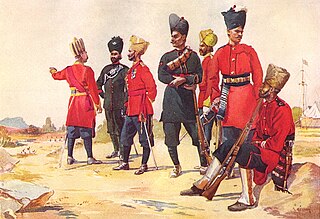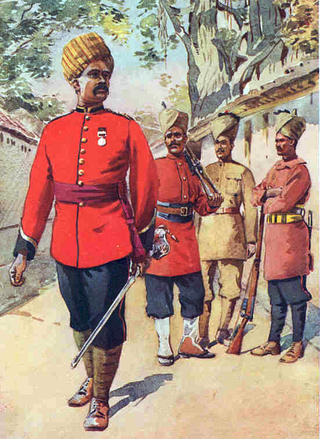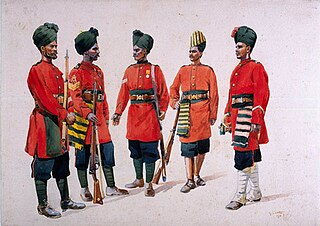Related Research Articles

The Kumaon Regiment is one of the oldest infantry regiments of the Indian Army. The regiment traces its origins to the 18th century and has fought in every major campaign of the British Indian Army and the Indian Army, including the two world wars, and is one of the highest decorated regiments of the Indian army.

The Deccan Horse or 9 Horse is one of the oldest and most decorated armoured regiments of the Indian Army. The Royal Deccan Horse , which was a regular cavalry regiment of the British Indian Army was formed from the amalgamation of two regiments after World War I. They saw service from the Mutiny of 1857 up to and including World War II.
The 9th (Secunderabad) Division was an infantry division formation of the British Indian Army. It was part of the Southern Army and was formed in 1904 after Lord Kitchener was appointed Commander-in-Chief, India between 1902 and 1909. He instituted large-scale reforms, including merging the three armies of the Presidencies into a unified force and forming higher level formations, eight army divisions, and brigading Indian and British units. Following Kitchener's reforms, the British Indian Army became "the force recruited locally and permanently based in India, together with its expatriate British officers."

The Imperial Service Troops were forces raised by the princely states of the British Indian Empire. These troops were available for service alongside the Indian Army when such service was requested by the British government. At the beginning of the 20th century, their total numbers were about 18,000 men.
The 108th Infantry were an infantry regiment of the British Indian Army. The regiment traces their origins to 1768, when they were raised as the 1st Battalion, Bombay Sepoys.

The 109th Infantry was an infantry regiment of the British Indian Army. The regiment traces its origins to 1768, when it was raised as the 5th Battalion, Bombay Sepoys.

The 112th Infantry were an infantry regiment of the East India Company's Bombay Army and later the British Indian Army. The regiment traces their origins to 1796, when they were raised as the 2nd Battalion, 6th Regiment of Bombay Native Infantry.

The 113th Infantry were an infantry regiment of the British Indian Army. The regiment traces their origins to 1800, when they were raised as the 1st Battalion, 7th Regiment of Bombay Native Infantry.

The 11th Rajputs was an infantry regiment of the Bengal Army and later of the British Indian Army. They could trace their origins to 1825, when they were the 2nd Extra Battalion, Bengal Native Infantry. In 1828, they were renamed the 70th Bengal Native Infantry and a number of changes in name followed - the 11th Bengal Native Infantry 1861–1885, the 11th Bengal Infantry 1885–1897, the 11th (Rajput) Bengal Infantry 1897–1901, the 11th Rajput Infantry 1901–1903. Finally in 1903, after the Kitchener reforms of the Indian Army - the 11th Rajputs.
The 97th Deccan Infantry was an infantry regiment of the British Indian Army. They could trace their origin to 1794, when they were the 3rd Battalion of the Aurangabad Division in the Hyderabad State army. Which took part in the Battle of Seringapatam in the Fourth Anglo-Mysore War.
The 79th Carnatic Infantry was an infantry regiment of the British Indian Army. They could trace their origins to 1777, when the 20th Carnatic Battalion was raised from sub-units of the 1st, 3rd, 8th and 16th Carnatic Battalions.
The 67th Punjabis were an infantry regiment of the British Indian Army. They could trace their origins to 1759, when they were raised as the 8th Battalion Coast Sepoys.
The 94th Russell's Infantry were an infantry regiment of the British Indian Army. They could trace their origins to 1813, when they were raised as the 1st Battalion of the Russell Brigade for the Princely state of Hyderabad. Until 1853, the regiment was part of the Nizam of Hydrabad's Army then after signing of a treaty with the then Governor General of India, The Nizam's Contingent was renamed as the Hyderabad Contingent and became part of the regular Indian Army.
The 95th Russell's Infantry were an infantry regiment of the British Indian Army. They could trace their origins to 1813, when they were raised as the 2nd Battalion of the Russell Brigade for the Princely state of Hyderabad. Until 1853, the regiment was part of the Nizam of Hydrabad's Army, then after signing of a treaty with the then Governor-General of India, The Nizam's Contingent was renamed as the Hyderabad Contingent and became part of the regular Indian Army.
The 96th Berar Infantry were an infantry regiment of the British Indian Army. They could trace their origins to 1797, when they were raised as the 2nd Battalion of the Aurangabad Division for the Princely state of Hyderabad. Until 1853, the regiment was part of the Nizam of Hydrabad's Army then after signing of a treaty with the then Governor General of India, The Nizam's Contingent was renamed as the Hyderabad Contingent and became part of the regular Indian Army.
The 98th Ahir Infantry was an infantry regiment of the British Indian Army. It could trace its origins to 1788, when it was raised as the 1st Battalion of the Ellichpur Brigade for the Princely state of Hyderabad. Until 1853, the regiment was part of the Nizam of Hydrabad's Army; then, after the signing of a treaty with the then Governor General of India, the Nizam's Contingent was renamed the Hyderabad Contingent and became part of the regular Indian Army.

The 107th Pioneers were an infantry regiment of the British Indian Army. Their origin can be traced back to 1788, when they were raised as the 4th Battalion, Bombay Sepoys.

The 116th Mahrattas were an infantry regiment of the British Indian Army. The regiment traces their origins to 1800, when they were raised as the 2nd Battalion, 7th Regiment of Bombay Native Infantry.
The 121st Pioneers were an infantry regiment of the East India Company's Bombay Army and later the British Indian Army. The regiment traces their origins to 1777, when they were raised as the Marine Battalion.

The Nizam's Contingent, later Hyderabad Contingent, was the army funded by the Nizam of Hyderabad, the ruler of a Princely state of India.
References
Notes
- ↑ "Nanded District". maharashtra.gov. Retrieved 28 September 2009.
- ↑ Sumner p.15
Bibliography
- Barthorp, Michael; Burn, Jeffrey (1979). Indian infantry regiments 1860-1914. Osprey Publishing. ISBN 0-85045-307-0.
- Moberly, F.J. (1923). Official History of the War: Mesopotamia Campaign, Imperial War Museum. ISBN 1-870423-30-5
- Rinaldi, Richard A (2008). Order of Battle British Army 1914. Ravi Rikhye. ISBN 978-0-9776072-8-0.
- Sharma, Gautam (1990). Valour and sacrifice: famous regiments of the Indian Army. Allied Publishers. ISBN 81-7023-140-X.
- Sumner, Ian (2001). The Indian Army 1914-1947. Osprey Publishing. ISBN 1-84176-196-6.